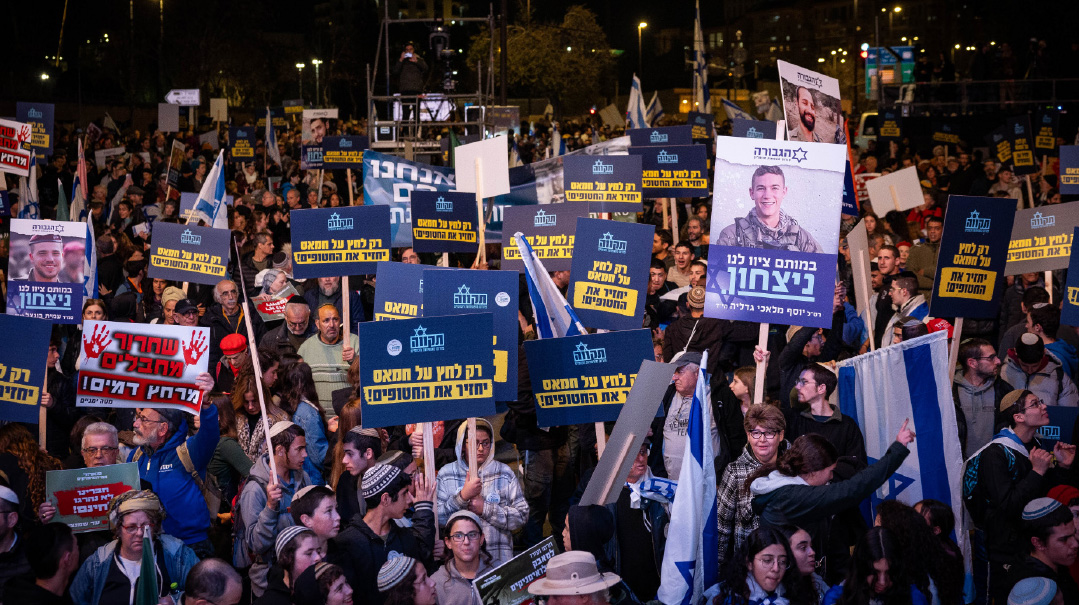Not At Any Price

A hostage deal that left Hamas still in control of Gaza would be snatching defeat from the jaws of victory

S
ometimes I come across an argument so wrong-headed that it allows me to crystallize a lot of related thoughts. A recent op-ed piece in the Jerusalem Post by a fellow at the Jewish People Policy Institute provides a good example.
The author, who will remain nameless to spare her embarrassment, began by citing psychological experiments that show people fear losing more than they enjoy winning. Few people, for instance, will take a bet that offers them equal odds of winning $50 or losing $50. Only if the possible upside is increased considerably will they risk losing what they already have.
Based on that phenomenon, the author argued that returning Israeli hostages, who represent a loss so long as they are in captivity, should take precedence over winning the war to destroy Hamas.
The author seemed quite pleased with her cleverness. But her piece reminded me of nothing so much as the Harvard Law Review student notes of my misspent youth, in which a student offered a “clever” and inevitably unsatisfying solution to a well-known philosophical or legal conundrum. That brand of cleverness was represented in the recent Republican primaries by Vivek Ramaswamy, who, based on his academic record and billionaire status at a young age, almost surely had the highest IQ of any of the candidates. Yet his too-clever answers and putdowns of other candidates only served as reminders — to me, at least — that intelligence and wisdom are not one continuum and that the most intelligent person is often the least wise.
ON ITS FACE, the analogy of the JPPI fellow makes little sense. In the experiments she cited, it was easy to measure both gain and loss on a single scale — dollars. The real world is not like that. How does one measure, for instance, lives of captives who would hopefully be saved by a hostage deal against the potentially far greater loss of life later as a consequence of the deal? Or against the pain of families who suffered the loss of or severe injury to loved ones serving in the IDF in the current war, and who would be left feeling that the sacrifices of those loved ones were in vain if the war ends with Hamas unvanquished?
Most crucially, the author was playing word games in her definition of gain and loss. The failure to defeat Hamas is not simply the absence of a gain (military victory), but a loss. At present, hundreds of thousands of Israeli Jews from both the south and north have been uprooted from their homes — with the concomitant cost of livelihoods and a lifetime of social relationships. That is a loss. If Hamas is not removed from Gaza, it is questionable whether those who lived near Gaza will ever agree to return home. That contraction of Israel’s populated areas is surely a major loss.
In addition, the diminution of Israel’s deterrence power from a failure to rout Hamas — another loss — would embolden both Hezbollah and its Iranian sponsors, and thereby make it less likely that northern residents would return to their homes either.
Were Israel to agree to a deal to bring the hostages home “at any price,” including abandoning a war undertaken with single clear aim — to ensure that Hamas is never again in a position to butcher Israeli citizens in an attack such as that which took place on October 7 — we would thereby demonstrate the effectiveness of seizing captives and ensure that there will be many more such captives in the future.
Further, it is clear that Hamas is demanding that Israel return of hundreds of security prisoners with blood on their hands in exchange for the captives. Past experience makes clear that freeing such people only results in more Jewish blood being shed in the future. Hamas leader Yahya Sinwar, the mastermind behind the October 7 savagery, was one of more than a thousand Palestinian security prisoners exchanged for IDF soldier Gilad Shalit in 2011. While we cannot identify who will be the next Sinwar in the event of a security-prisoners-for-captives exchange, that there will be one or many Sinwars returned to Gaza is a virtual certainty.
In short, failing to destroy Hamas would not only be a non-win, it would constitute a long series of losses.
INADDITION, a hostage deal that left Hamas still in control of Gaza would be snatching defeat from the jaws of victory. John Spencer, chairman of Urban Warfare Studies at West Point’s Modern Warfare Institute, recently compared Israel’s battle against Hamas to that of US and Iraqi forces against ISIS in Mosul. In Mosul, the Iraqi and US forces confronted 3,000 to 5,000 ISIS fighters in one city, and victory took eleven months and left Mosul destroyed. Israel, by contrast, faced 30,000 Hamas fighters, in seven cities, using human shields, and hunkered down in military-grade underground cities beneath civilian areas. And yet, despite the enemy’s far greater military challenge, Israeli forces are moving at a “historic pace” for this type of urban warfare.
And Israel has achieved this, according to Spencer, while “implement[ing] more measures to prevent civilian casualties than any other military in history,” including daily pauses to allow evacuation of civilians, millions of phone calls and SMS messages to aid that evacuation, and providing detailed maps of areas where the Israeli army will be operating. According to Col. Richard Kemp, former head of British expeditionary forces in Afghanistan, the ratio of civilian to combatant casualties — 1.5:1 — is historically low.
Tablet magazine’s February 6 edition of The Scroll details how Israeli innovation has thwarted American hopes of using its leverage over Israel to realize the US’s decades-old dream of imposing a Palestinian state on Israel. Initially, the Biden administration expected Gaza to prove a quagmire for Israel that would bring down the Netanyahu coalition and bring in one more compliant to American wishes. And just to up the pressure and try to lessen the anger of progressive Democrats, the Biden administration has kept up a steady drumbeat of criticism of Israel for Palestinian civilian casualties, culminating in President Biden terming Israel’s military response “over the top” last week.
American hopes mirrored those of the Israeli left and its allied media, which has never and will never give up its efforts to bring down Netanyahu at the earliest possible moment. That media has kept up a steady drumbeat of negative reporting from Gaza about how badly the war is going.
But over the past month, the IDF has largely succeeded in mapping Hamas’s tunnel network, through a combination of technology and intelligence. And that has in turn made it possible to break apart the network by creating large holes in the ground that divide the segments of each tunnel from one another, each segment containing smaller and smaller isolated groups of Hamas fighters, thereby allowing the methodical elimination of Hamas units. Hamas casualties have jumped considerably, without any corresponding increase in casualties of IDF soldiers or Gazan civilians. Israel is achieving this with excavators and regular weaponry, and is thus far less dependent on high-tech American arms than at the outset.
Which brings us to the final weakness of the Jerusalem Post op-ed: There is no need to rely on far-fetched analogies to determine what path Israelis should favor. We can just ask them whether they wish to abandon the goal declared after October 7 of eliminating Hamas from the Gaza Strip.
Were the government to agree now to bring the war on Hamas to a halt or to an extended cease-fire, it would face a horrible backlash from two groups of voters, each numbering in the hundreds of thousands. The first of those consists of displaced residents of the north and south, who cannot yet return to their homes, and will never be able to if Hamas remains in place. And the second is those reservists and soldiers in the standing army who have sacrificed so much to bring Israel to the cusp of victory today.
Fortunately for Prime Minister Netanyahu, whose political survival depends on a decisive victory over Hamas, Hamas’s counterproposal to the cease-fire and hostage exchange proposals put to it was so absurd — complete Israeli withdrawal from Gaza, the end of all hostilities, massive humanitarian aid, and the release of thousands of Hamas prisoners — that in Netanyahu’s words, no sane person could contemplate accepting it.
About that he is surely right.
(Originally featured in Mishpacha, Issue 999. Yonoson Rosenblum may be contacted directly at rosenblum@mishpacha.com)
Oops! We could not locate your form.







